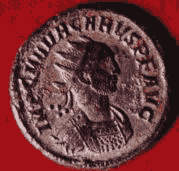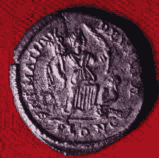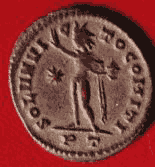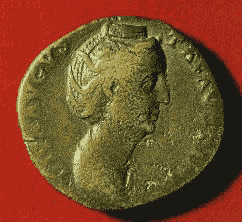 |
 |
 |
 |
 |
EC.72.1 Denomination: as Date: c. 200 BCE Obverse: Head of Janus Notes: Janus was a major figure in early Roman mythology, seen as the god of all beginnings and a spirit occupying gateways. He is commonly depicted with two heads, one looking into the past and one looking into the future. An identical coin is reproduced in R. A. G. Carson's Principal Coins of the Romans; Vol. 1: The Republic c. 290-31BC (London: British Museum, 1978): no. 47.
|
 |
Reverse: Prow of a ship
Inscription: ROMA Notes: This coin came into circulation after the Second Punic War (218-201 BCE), when Romans instituted a new monetary system to defray expenses incurred while fighting against the Carthaginian general Hannibal. Ancient Roman coinage, the appearance of which is indebted to the Greeks, is generally struck--not cast--accounting for its raised edges and irregular shape. Weight: 16 g
|
 |
EC.72.2 Denomination: as Date: 27 BCE - 14 CE Obverse: Head of Julius Caesar facing right
Inscription: DIVOS IULIUS
|
 |
Reverse: Head of Augustus facing right
Inscription: CAESAR DIVI F Notes: After taking control of the treasury, Julius Caesar instituted portraiture of living rulers on coins, placing his likeness on a coin for the first time in 44 BCE. This coin, however, was not issued during the lifetime of Julius Caesar, but by his adopted son, Augustus. It was common practice for a new emperor to link himself to a predecessor, even if the relation was speciously remote, implying he not only had a right to office but would exhibit the same virtues and strengths, ensuring political stability. Weight: 13 g
|
 |
EC.72.3 Denomination: denarius Date: c.40 BCE Obverse: Figure of an elephant, likely crushing a dragon Inscription: CAESAR Notes: The elephant on the obverse of the coin was the family badge for the Caesars.
|
 |
Reverse: Priestly symbols (a torch and dagger) Notes: The denarius was introduced c. 210 BCE in solid silver. It quickly became the major currency in the Mediterranean. This coin (EC.72.3) is probably an ancient forgery. Forgery was commonplace in the Roman Republic and coins frequently bear cut marks, as does this one, showing that their authenticity had been tested. Our coin appears to be silver-plated bronze, so it likely failed the test. An identical coin is reproduced in R. A. G. Carson's Principal Coins of the Romans; Vol. 1: The Republic c. 290-31BC (London: British Museum, 1978): no. 207. Weight: 2 g
|
 |
EC.72.4 Denomination: as Date: c. 7 BCE Obverse: Uncrowned, beardless head of Augustus facing left
Inscription: IMP CAESAR DIVI F AUGUSTUS IMP XX
|
 |
Reverse: No figure
Inscription: PONTIF MAXIM TRIBUN POT XXXIIII. SC Weight: 10 g
|
 |
EC.72.5 Denomination: as Date: c. 14-37 CE Obverse: Uncrowned, beardless head of Augustus facing left
Inscription: DIVUS AUGUSTUS PATER
|
 |
Reverse: A funeral altar called the Altar of Providence
Inscription: PROVIDENT. SC Notes: This coin was issued during the reign of Tiberius. This coin is identical to EC.72.6 and EC.72.7. An identical coin is reproduced in R. A. G. Carson's Principal Coins of the Romans; Vol. 2: The Principate 31BC-AD296 (London: British Museum, 1980): no. 375. Weight: 10 g
|
 |
EC.72.6 Denomination: as Date: c. 14-37 CE Obverse: Uncrowned, beardless head of Augustus facing left
Inscription: DIVUS AUGUSTUS PATER
|
 |
Reverse: Funeral altar called the Altar of Providence
Inscription: PROVIDENT. SC Notes: This coin is identical to EC.72.5 and EC.72.7 . An identical coin is reproduced in R. A. G. Carson's Principal Coins of the Romans; Vol. 2: The Principate 31BC-AD296 (London: British Museum, 1980): no. 375. Weight: 10 g
|
 |
EC.72.7 Denomination: as Date: c. 14-37 CE Obverse: Uncrowned, beardless head of Augustus facing left
Inscription: DIVUS AUGUSTUS PATER
|
 |
Reverse: Funeral altar called the Altar of Providence
Inscription: PROVIDENT. SC Notes: This coin is identical to EC.72.5 and EC.72.6. An identical coin is reproduced in R. A. G. Carson's Principal Coins of the Romans; Vol. 2: The Principate 31BC-AD296 (London: British Museum, 1980): no. 375. Weight: 7 g
|
 |
EC.72.9 Denomination: as Date: after 14 CE Obverse: Uncrowned, beardless head of Augustus facing left
Inscription: DIVUS CAESAR AUG P M |
 |
Reverse: Faint striding figure facing right Notes: This coin was most likely issued under the reign of Tiberius (see EC.72.16 through EC.72.20, and EC.72.21 for more coins and information on Tiberius). Weight: 8 g
|
 |
EC.72.10 Denomination: sestertius Date: c. 138-161 CE Obverse: uncrowned, beardless head of Augustus facing right
Inscription: DIVUS AUG...
|
 |
Reverse: Standing woman
Inscription: SC Notes: This coin was likely issued under the reign of Antoninus Pius Weight: 20 g
|